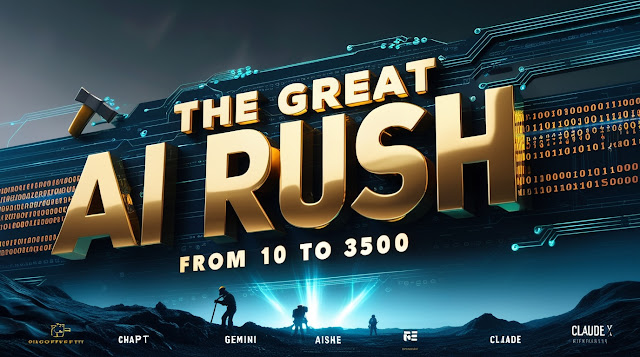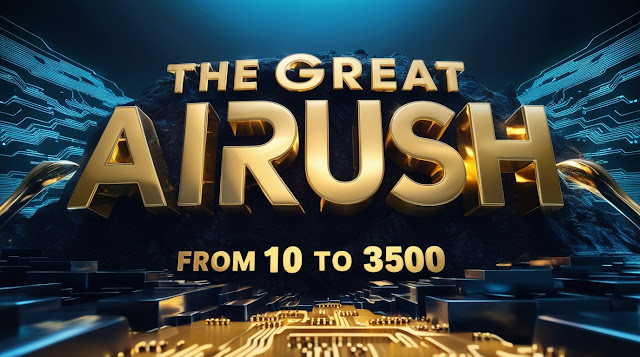This is the tale of OpenAI, a company that went from "Who are they?" to "OH MY GOD, THEY'RE EVERYWHERE!" faster than you can say "Hey ChatGPT, write me a sonnet about blockchain."
 |
| The Great AI Rush: How OpenAI Went from 10 to 3,500 Employees |
It's 2015, and a bunch of tech wizards decide to start a company dedicated to artificial intelligence. Among them is Elon Musk, because apparently running Tesla and SpaceX wasn't keeping him busy enough. It's like when your overachieving friend signs up for another marathon while simultaneously learning Japanese and writing a novel – we get it, you're productive!
They start with just 10 employees. TEN! That's barely enough people to form a decent lunch queue. Fast forward to 2024, and they've got 3,531 employees. That's not growth, that's what happens when you leave tribbles in your office overnight! They went from "We can all fit in one elevator" to "We need our own zip code" in less time than it takes most people to finish binge-watching their Netflix watchlist.
But here's where it gets really interesting. In 2019, they did something that sounds like an oxymoron – they became a "capped-profit" company. It's like saying you're going on a diet but keeping unlimited access to chocolate cake.
Microsoft looked at this bizarre business model and said, "Shut up and take our billion dollars!" Because nothing says "We believe in your non-profit ideals" quite like dumping a billion dollars in someone's lap.
Speaking of their employees, let's talk about their workforce distribution. A whopping 87.1% of their employees are based in the US, which makes sense because where else would you put a company that's trying to create artificial general intelligence?
Silicon Valley has become to AI what Hollywood is to movies, except with more comfortable shoes and fewer dramatic breakups (we think).
The educational background of OpenAI's employees reads like an Ivy League alumni newsletter. Stanford, Berkeley, MIT – it's like they're collecting prestigious universities like Pokemon cards.
They've got so many PhDs in their offices, if you shout "Doctor!" in the cafeteria, half the room probably turns around.
And what did these brilliant minds study? Well, 35.6% studied Computer Science, which is about as surprising as finding out that chefs studied cooking. But here's the fun part – they've also got people who studied Psychology.
Because apparently, before you can create artificial intelligence, you need to understand actual intelligence (or lack thereof, as evidenced by my social media feed).
Their department distribution is equally fascinating. The largest department is Engineering at 33.9%, followed by Operations at 13.4%.
I'm not entirely sure what the Operations department does, but I imagine it involves a lot of people saying "Have you tried turning it off and on again?" to increasingly sophisticated AI systems.
The company's growth has been so explosive that by 2024, they had to hire 2,761 new people in just one year. That's not HR recruitment; that's HR running a small country! Imagine being the person in charge of ordering office supplies. "Yes, I need 2,761 new desk chairs. No, this is not a prank call."
But perhaps the most remarkable thing about OpenAI's journey is how they've managed to maintain their original mission of ensuring AI benefits all of humanity, while simultaneously becoming one of the most valuable companies in tech.
It's like watching a street performer who started out juggling tennis balls and is now casually tossing flaming chainsaws while riding a unicycle – impressive, slightly terrifying, but you can't look away.
So what's next for OpenAI? Well, if their growth trajectory continues at this rate, by 2030 they'll probably employ more people than there are stars in the visible universe. They'll have to start hiring in parallel dimensions just to keep up with their expansion plans.
And let's not forget ChatGPT, their crown jewel, which has become so popular that "Let me ask ChatGPT" has replaced "Let me Google that" as the go-to phrase for avoiding actual research. It's like having a know-it-all friend who actually knows it all and doesn't get tired of your endless questions about whether hot dogs are sandwiches.
OpenAI's journey from 10 employees to over 3,500 is not just a story of corporate growth – it's a testament to what happens when you combine brilliant minds, ambitious goals, and enough computing power to make a supercomputer blush.
They've shown us that when it comes to artificial intelligence, the sky's not the limit; it's just the beginning. Though at this rate, they might need to hire someone to invent new metaphors for growth, because "exponential" just doesn't cut it anymore.
Just remember, somewhere in an alternate universe, there's probably an AI writing an equally amusing article about the growth of human intelligence. And wouldn't that be something to think about?
 |
| The Incredible Tale of OpenAI: From Garage Band to Rock Stars of AI |
Timeline of OpenAI's Employee Count
Here is a timeline that shows the staff/team count since the companies inception:
|
Year |
Number of Employees |
Growth (Number) |
Growth (%) |
|---|---|---|---|
|
2015 |
10 |
- |
- |
|
2016 |
25 |
↑ 15 |
↑ 150% |
|
2017 |
45 |
↑ 20 |
↑ 80% |
|
2018 |
80 |
↑ 35 |
↑ 77.8% |
|
2019 |
150 |
↑ 70 |
↑ 87.5% |
|
2020 |
250 |
↑ 100 |
↑ 66.7% |
|
2021 |
300 |
↑ 50 |
↑ 20% |
|
2022 |
375 |
↑ 75 |
↑ 25% |
|
2023 |
770 |
↑ 395 |
↑ 105.3% |
|
2024 |
3,531 |
↑ 2,761 |
↑ 358.6% |
OpenAI Employee Statistics
These are some of the most notable statistics about the personnel at OpenAI:
Where do OpenAI Employees Live?
The largest amount of their employees (87,1%) is based in the US.
|
Country |
Number of Employees |
Percentage |
|---|---|---|
|
United States |
3,144 |
87.1% |
|
India |
221 |
6.1% |
|
United Kingdom |
312 |
8.6% |
What Positions are the Employees in
An very large amount (33,9%) work in the engineering department of OpenAI.
|
Role |
Number of Employees |
Percentage |
|---|---|---|
|
Engineering |
1,199 |
33.9% |
|
Operations |
474 |
13.4% |
|
Business Development |
346 |
9.8% |
|
Information Technology |
335 |
9.5% |
|
Education |
230 |
6.5% |
|
Sales |
196 |
5.5% |
|
Human Resources |
188 |
5.3% |
|
Research |
173 |
4.9% |
|
Media and Communication |
167 |
4.7% |
|
Arts and Design |
122 |
3.5% |
|
Entrepreneurship |
119 |
3.4% |
|
Community and Social Services |
106 |
3.0% |
|
Product Management |
94 |
2.7% |
|
Administrative |
91 |
2.6% |
|
Marketing |
87 |
2.5% |
Where did OpenAI's Employees Study?
Here are the most common universities OpenAI's employees graduated from.
|
University |
Number of Employees |
Percentage |
|---|---|---|
|
Stanford University |
192 |
13.0% |
|
University of California, Berkeley |
167 |
11.3% |
|
Massachusetts Institute of Technology |
107 |
7.2% |
|
Carnegie Mellon University |
89 |
6.0% |
|
Harvard University |
71 |
4.8% |
|
UCLA |
62 |
4.2% |
|
University of Southern California |
46 |
3.1% |
|
University of Washington |
42 |
2.8% |
|
New York University |
41 |
2.8% |
|
University of Oxford |
40 |
2.7% |
|
Caltech |
38 |
2.6% |
|
Yale University |
36 |
2.4% |
|
Princeton University |
34 |
2.3% |
|
University of Illinois Urbana-Champaign |
33 |
2.2% |
|
Columbia University |
32 |
2.2% |
What Did OpenAI's Workforce Study?
As most of the employees have engineering positions, most of them naturally studied some kind computer science.
|
Field of Study |
Number of Employees |
Percentage |
|---|---|---|
|
Computer Science |
800 |
35.6% |
|
Computational Science |
623 |
27.7% |
|
Economics |
144 |
6.4% |
|
Mathematics |
116 |
5.2% |
|
Political Science and Government |
107 |
4.8% |
|
Business Administration and Management, General |
98 |
4.4% |
|
Electrical and Electronics Engineering |
87 |
3.9% |
|
Computer Engineering |
85 |
3.8% |
|
Artificial Intelligence |
78 |
3.5% |
|
Physics |
74 |
3.3% |
|
Computer Software Engineering |
67 |
3.0% |
|
Computer Engineering Technologies/Technicians |
63 |
2.8% |
|
Finance, General |
58 |
2.6% |
|
Electrical Engineering and Computer Science |
55 |
2.4% |
|
Psychology |
50 |
2.2% |
If you are interested in more OpenAI statistics, make sure to check out our article on how many users ChatGPT has.
OpenAI's Highlights Since Launch
OpenAI has grown to be one of the biggest and most influential companies in the world in just 9 years. Here are some of the most notable moments since they were founded in December 2015.
Founding of OpenAI (2015)
OpenAI was founded in December 2015 in San Francisco by Elon Musk, Sam Altman, Greg Brockman, Ilya Sutskever, Wojciech Zaremba, and John Schulman. The organization was established with the mission to ensure that artificial general intelligence (AGI) benefits all of humanity.
Transition to Capped-Profit Model (2019)
In 2019, OpenAI transitioned from a non-profit to a "capped-profit" model. This change allowed the organization to attract more investment while maintaining its commitment to ethical AI development.
Partnership with Microsoft (2019)
Also in 2019, OpenAI entered into a significant partnership with Microsoft, which invested $1 billion to support OpenAI's research and development. This partnership has been crucial in accelerating OpenAI's growth and technological advancements.
Release of GPT-3 (2020)
In June 2020, OpenAI released GPT-3, the third generation of its Generative Pre-trained Transformer language model. GPT-3 garnered widespread attention for its advanced natural language processing capabilities, setting a new standard in AI language models.
Key Revenue Milestone (2021)
In 2021, OpenAI achieved a key revenue milestone by generating over $100 million in annual recurring revenue. This milestone highlighted the commercial viability and growing demand for OpenAI's AI technologies.
Launch of ChatGPT (2022)
In 2022, OpenAI launched ChatGPT, a state-of-the-art conversational AI model. ChatGPT quickly became one of the most popular AI tools, demonstrating OpenAI's leadership in the field of artificial intelligence.
Expansion of Workforce (2024)
By September 2024, OpenAI's workforce had expanded to 3,531 employees, a significant increase from the 770 employees in November 2023. This growth underscores the company's rapid expansion and rising influence in artificial intelligence.
 |
| From Nerds to Ninjas: OpenAI's Explosive Journey to Tech Stardom |
OpenAI's meteoric rise from a tiny startup to an AI powerhouse. This chronicles how a band of tech visionaries transformed their 10-person operation into a 3,500-strong workforce, all while revolutionizing artificial intelligence. Packed with statistics, this piece offers a perspective on Silicon Valley's most remarkable growth story, from billion-dollar deals to PhD-packed cafeterias.
#OpenAI #ArtificialIntelligence #ChatGPT #TechGrowth #SiliconValley #StartupLife #AI #Innovation #TechIndustry #SamAltman #ElonMusk #Microsoft #TechJobs #FutureOfWork #AIRevolution

